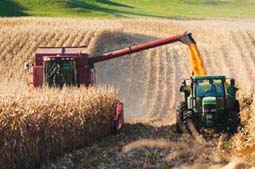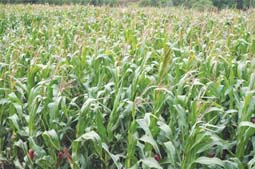More Silage, Less Food

As farmers in Kenya chop maize for cattle feed, food security worries continue to grow. However the practice seems to be growing at a very high speed. To understand the reasons, Cereals Magazine’s Mary Mwende spoke to Mr. Nicholas Mbatha (below) an agronomist with Corteva Agriscience.
“Why silage maize grain and not normal maize grain”
She asked. Eloquently, Mr. Mbatha answered, “The production cost of growing maize for grain is high with little returns compared to that of silage maize. In Silage maize growing, nothing goes to waste, i.e. the cobs, the kernels, the stalks. In comparison, time taken from growing to harvest is short. Lastly, normal maize is subject to post harvest loses.”
Technology
Living in an evolving world means that technology and innovation is an extensive field that is also dynamic. Feeding livestock has never been this easy in the 21st century, bearing in mind that animal feeds contribute a larger percentage to the well-up and out-put of animals especially the livestock.
Regardless of drought and unstable climatic conditions, farmers have always found alternative ways to their animals feed if not to supplement their diets. Maize Silage is one of such milestones and it has by far proven to be the best animal feed especially to dairy farmers who have so far had an experience of the product first hand. With the help of agronomists, agrochemicals and research institutions, farmers have been provided with adequate information and silage maize hybrids that are of good quality specifically adapted to climatic conditions of particular regions.
Silage is basically fermented fodder/Forage. Especially made from the high moisture-green foliage crops such as maize. Forage here refers to crops, annual or biennial, which are grown to be utilized by grazing or harvesting as a whole crop. It can be fed to cud-chewing animals such as goats, sheep and Cows. Ensilage on the other hand is fermentation and storage process of the silage. The crop goes through an array of processes during the ensiling process.
The things that take place during the fermentation process determine the quality and quantity of stored feed that will be available at feed out. There are three interacting factors that determine the resulting silage quality and they are; chemical composition of the plant, air exclusion and bacteria. The air in silage is controlled by the size of the chop, moisture content, packing, silo size and extent of sealing.
 Choice of Quality Silage Hybrid (Seeds)
Choice of Quality Silage Hybrid (Seeds)
In light with research, a good silage hybrid must start out as a good grain hybrid because you cannot overcome lack of starch (>90% digestible) with small increases in fiber digestibility (60-70% digestible). It is also worthy noting that, not every grain hybrid makes a good silage hybrid because they may be too short and not deliver the desired stover yield.
Therefore, selection of a good hybrid would entail; starch content which is energy dense component of the plant and influenced heavily by harvest maturity of the kernel and dry matter yield which is determined by plant height at the ear (Biomass yield) and starch (grain content). In addition, agronomic traits such as maturity, ability to withstand stress emergence during germination, climatetolerance, and disease resistance, harvesting stage among other traits are key.
Factors to Consider in Growing silage Maize Drainage-Maize does not perform well in waterlogged soils. This can reduce maize yield and also impact on silage quality, palatability and stock health. Drain areas with water ponds to allow earlier cultivation, better weed control and reduction in nutrient leaching.
Soil Test- Always do soil test to determine the most suitable fertilizer and lime input. Fertilizer requirements will vary greatly depending on the history and fertility status of the farm. Maize Hybrid- It is important to choose the correct maize hybrid for your area and farming system.Weed and insect control- Weeds compete strongly for sunlight, moisture and nutrients, therefore reducing production and quality. Grass weeds are most competitive and must be controlled early.
Factors to Consider in Harvesting of Silage Maize Maturity- Maturity can be monitored by kernel milk line development. The milk line is a visual division between the yellowish/whitish color of the seed coat (bottom of the kernel) and the whitish color of the seed towards the tip of the kernel. To maximize quality, maize should be harvested for silage when the kernels are ¾ milk line (dough stage). Between these stages, starch content is rising and fiber digestibility is in an optimum range. The moisture content should be about 65% for the stalk and 35% for the grain. Harvesting corn at lower-than-ideal DM brings about issues such as; Crop not achieving maximum starch deposition and sub-optimal energy and dry matter losses. In addition, silage will produce effluent (and greater storage losses due to effluent feed value) Farmers would also expect higher risk of butyric layers within the silage, protein degradation and greater likelihood of overly fermented silage.
Chop Height – should be between 4 to 8 inches, or 10cm
Chop Length - A short chop length allows high packing density and reduces air infiltration into the silo, while a longer chop length adds effective fiber in the diet. The correct chop length for maize depends on whether the crop is harvested conventionally, with or without a kernel processor (KP), or with a shredding processor.
Kernel Processing - Kernel processing influences the energy available in the rumen. Much of the advantage of processing maize silage is due to better kernel breakage and, therefore, higher kernel processing scores (KPS). The higher the dry matter, the more important it is to adequately process the grain.
The Ensiling Process
Phase 1: starts at harvest and under ideal conditions of moisture, chop length, and firm packing lasts only a few hours. In this phase (aerobic phase) live plant tissues present in the filled silo continue cell respiration due to plant enzymes and aerobic bacteria (oxygen dependent) present that uses the starch and oxygen thus releasing Carbon dioxide. The process goes on until the oxygen within the silo is depleted.
Phase 2: Here, oxygen is depleted. Hetero-fermentation occurs. Therefore, the bacteria that do not need oxygen Enterobacteria - (anaerobic) start using the starch in the plant material producing lactic acid, propionic and acetic acid among other organic acids. This goes on for about 48hours-72 hours contributing to a rise in temperatures inside the silo by the fermenting crop to about 90C, then the pH too drops from 6.0 -5.0.
Phase 3: After around 96 hours, the silage reaches a maximum temperature. The bacteria present transitions from aerobes and acetate tolerant bacteria to lactic acid producing bacteria. The potential water loss and nutrients is at its peak.
Phase 4: From Day 5 to Day 21, lactobacilli and streptococci bacteria are present and they convert carbohydrates to lactic acid, thus a drop in pH to 4.0. Homo-fermenters predominate. There’s a minimal cool down of the silage at this point.
Phase 5: In this stage, the silage is stable and remains in good quality for a long time as long as oxygen does not penetrate the silage. Still, another aerobic phase is bound to set in as the silage is removed from the silo.
Ensiling inoculants that are added during the silage fermentation process aid in;
- Reducing dry matter loss
- Reducing aerobic losses at feed out
- Improving bunk life
- Improving silage feeding quality
- Reducing overall feed cost
- Improving fiber digestibility
- Reducing protein degradation
- Conserving crop sugars
 Benefits of maize Silage
Benefits of maize Silage
Maize silage allows farmers to enjoy maximum benefits. It is advisable to any dairy farmer to take this advantage. This will optimize the stocking rate to achieve a higher pasture harvest even in a bumper pasture-growing season. As pasture levels fluctuate you can feed maize silage to maintain animal intakes.
It will also fill feed deficits by having maize silage on-hand; a farmer will never be short of feed. This will enable you to fill feed deficits throughout the season and lift per cow production.
Feeding maize silage in the dry season enables farmers to increase the number of cow milking days. Likewise, high energy, high starch- Maize grain contains more starch and energy than other cereal grains and has a relatively high level of bypass starch.
The digestibility of maize remains fairly consistent throughout the growing season. As the crop matures, the quality of stem and leaf declines, but this is offset by the increase in grain in the cob, which is highly digestible and high in starch. This is why harvesting at the correct stage is essential to maximize nutritional value. Cattle and sheep adapt to it easily in rations. It is Palatable and has a consistent feed value.
Corteva Agriscience’s Maize Hybrid Varieties
There has been a myth that yellow varieties are the best. However, Mr. Mbatha demystifies and rescinds this myth as some white varieties are also performing well. Corteva boasts of some of the best varieties in the country among them PAN 691-Medium altitude to High altitude suitable for Kiambu, Nakuru,Eldoret, Bome t,Bungoma,Nandi,Kitale,Kericho. They also have 3OG19-Medium-Medium wet suitable for Embu,meru,Nakuru,Migori,Kakameng a,Bungoma,Busia etc. For the Lowland- Medium they have PHB3253 suitable for Machakos ,Embu, Migori,Homabay, Meru, Embu etc. PAN 14(Yellow hybrid) is a Medium altitude which can do well in Meru, Embu,Nakuru,Migori,Siaya,Busia etc.